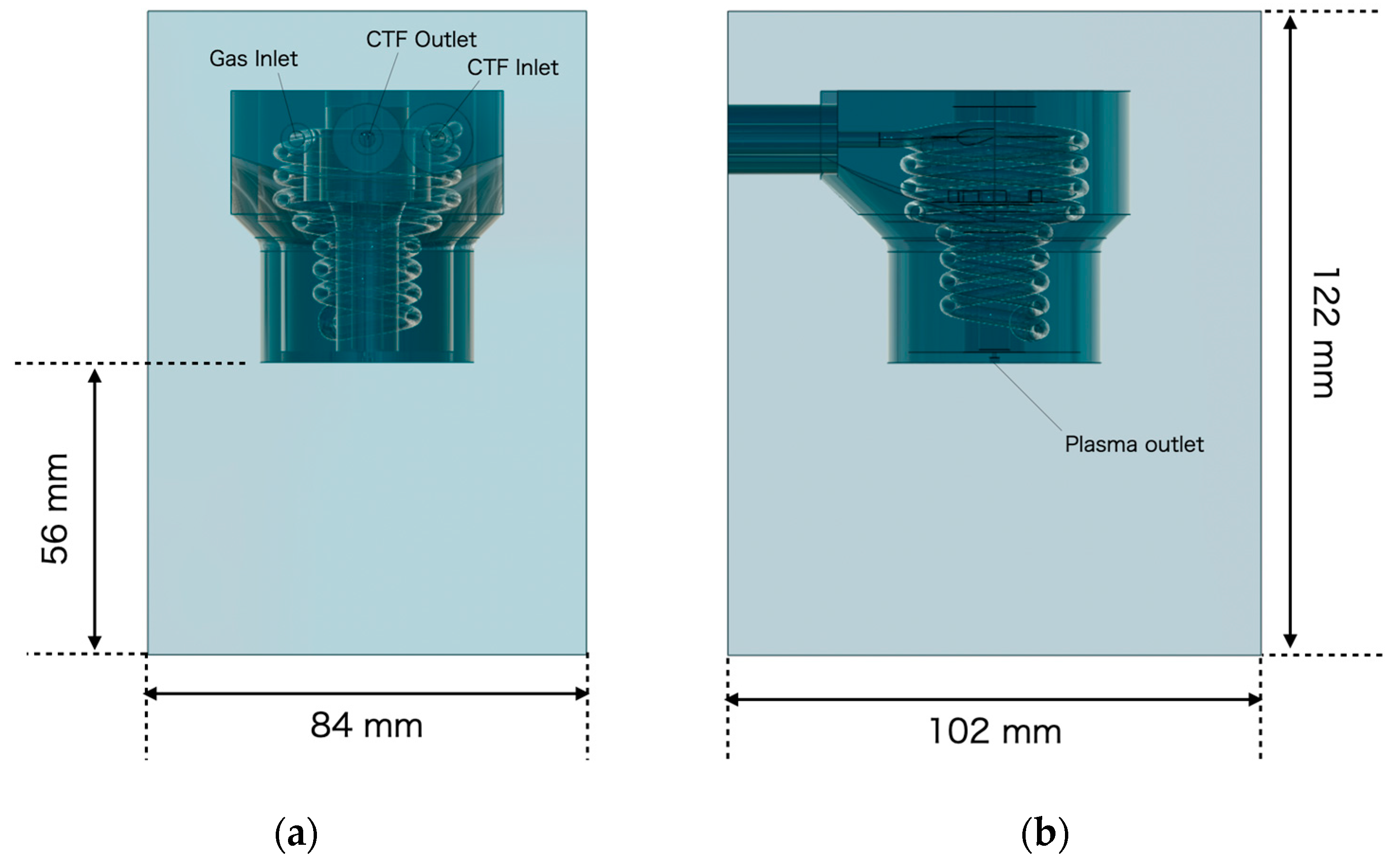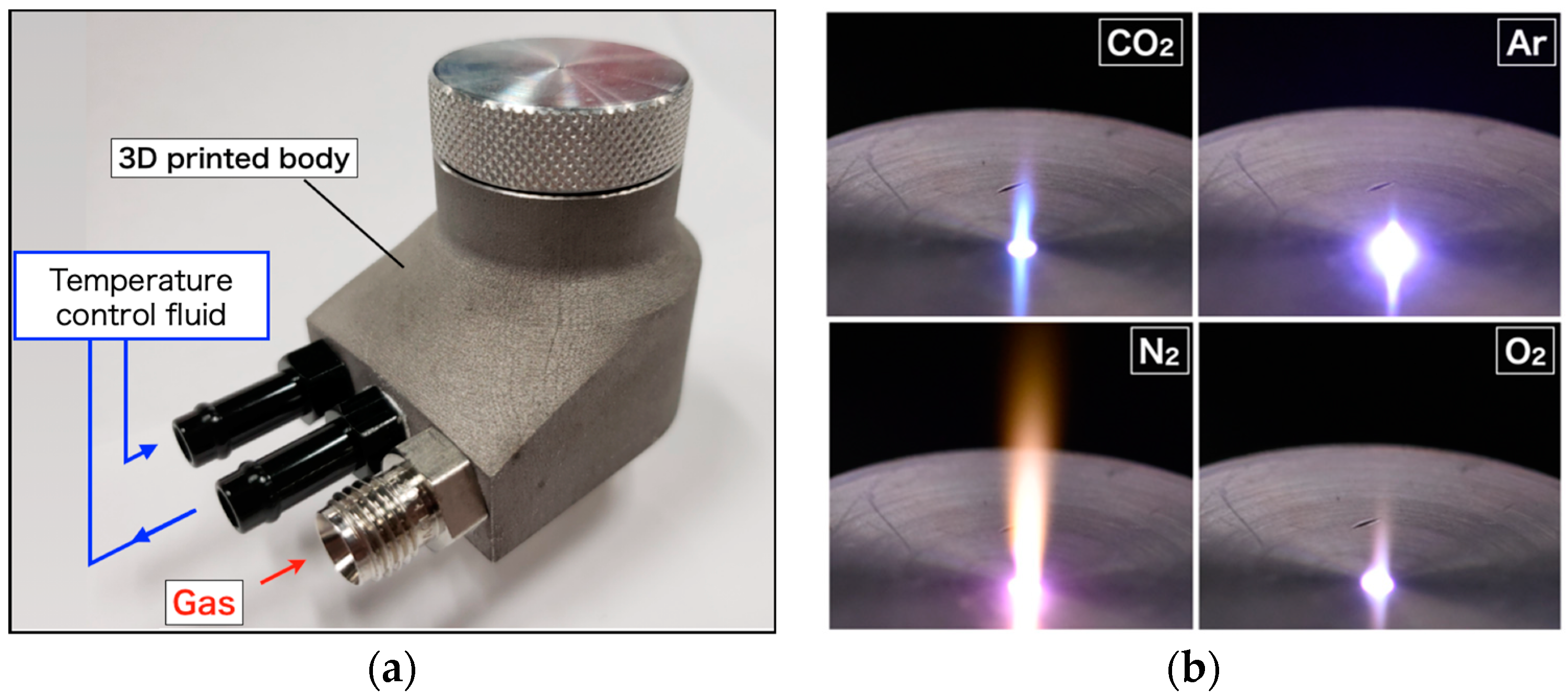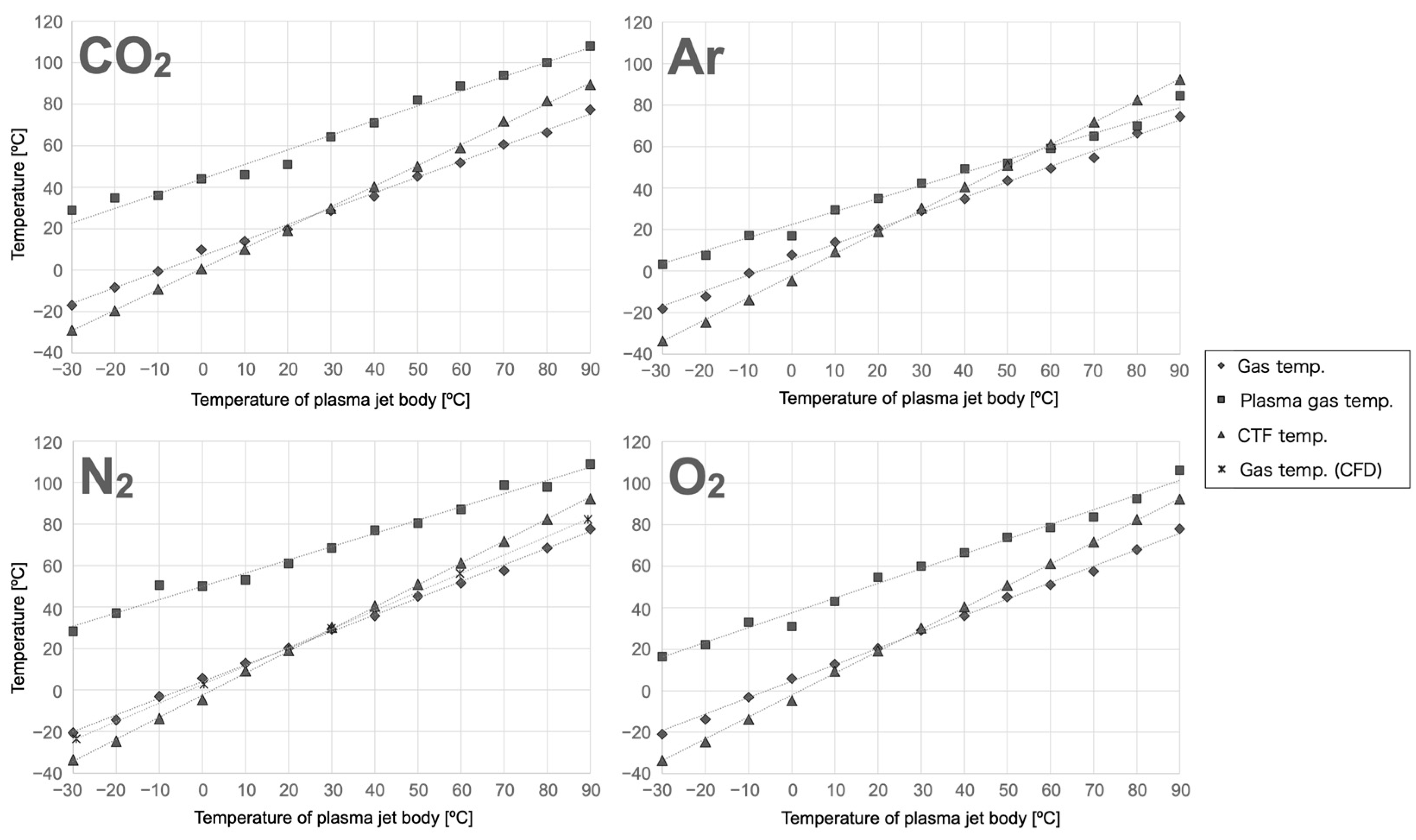Plasma Gas Temperature Control Performance of Metal 3D-Printed Multi-Gas Temperature-Controllable Plasma Jet
Abstract
1. Introduction
2. Materials and Methods
2.1. Concept of Multi-Gas Temperature-Controllable Plasma Jet
2.2. Evaluation of Temperature Control Performance Using CFD Analysis
2.3. Temperature Control Performance of Multi-Gas Temperature-Controllable Plasma Jet
3. Results and Discussion
3.1. Evaluation of Temperature Control Performance Using CFD Analysis
3.2. Fabrication of Multi-Gas Temperature-Controllable Plasma Jet
3.3. Temperature Control Performance of Multi-Gas Temperature-Controllable Plasma Jet
4. Conclusions
Author Contributions
Funding
Institutional Review Board Statement
Informed Consent Statement
Data Availability Statement
Acknowledgments
Conflicts of Interest
References
- Kashapov, N.F.; Sharifullin, S.N. Hardening of the Surface Plasma Jet High- Frequency Induction Discharge of Low Pressure. Mater. Sci. Eng. Pap. 2015, 86, 012021. [Google Scholar] [CrossRef]
- Wilson, D.J.; Williams, R.L.; Pond, R.C. Plasma Modification of PTFE Surfaces. Surf. Interface Anal. 2001, 31, 385–396. [Google Scholar] [CrossRef]
- Pan, J.; Li, Y.L.; Liu, C.M.; Tian, Y.; Yu, S.; Wang, K.L.; Zhang, J.; Fang, J. Investigation of cold atmospheric plasma-activated water for the dental unit waterline system contamination and safety evaluation in vitro. Plasma Chem. Plasma Process. 2017, 37, 1091–1103. [Google Scholar] [CrossRef]
- Maisch, T.; Shimizu, T.; Li, Y.F.; Heinlin, J.; Karrer, S.; Morfill, G.; Zimmermann, J.L. Decolonisation of MRSA, S. Aureus and E. Coli by Cold-Atmospheric Plasma Using a Porcine Skin Model In Vitro. PLoS ONE 2012, 7, e34610. [Google Scholar] [CrossRef]
- Abonti, T.R.; Kaku, M.; Kojima, S.; Sumi, H.; Kojima, S.; Yamamoto, T.; Yashima, Y.; Miyahara, H.; Okino, A.; Kawata, T.; et al. Irradiation Effects of Low Temperature Multi Gas Plasma Jet on Oral Bacteria. Dent. Mater. J. 2016, 35, 822–828. [Google Scholar] [CrossRef] [PubMed][Green Version]
- Fridman, G.; Peddinghaus, M.; Ayan, H.; Fridman, A.; Balasubramanian, M.; Gutsol, A.; Brooks, A.; Friedman, G. Blood Coagulation and Living Tissue Sterilization by Floating-Electrode Dielectric Barrier Discharge in Air. Plasma Chem. Plasma Process. 2006, 26, 425–442. [Google Scholar] [CrossRef]
- Shimatani, A.; Toyoda, H.; Orita, K.; Hirakawa, Y.; Aoki, K.; Oh, J.; Shirafuji, T.; Nakamura, H. In Vivo Study on the Healing of Bone Defect Treated with Non-Thermal Atmospheric Pressure Gas Discharge Plasma. PLoS ONE 2021, 16, e0255861. [Google Scholar] [CrossRef]
- Černáková, L.; Kováčik, D.; Zahoranová, A.; Černák, M.; Mazúr, M. Surface Modification of Polypropylene Non-Woven Fabrics by Atmospheric-Pressure Plasma Activation Followed by Acrylic Acid Grafting. Plasma Chem. Plasma Process. 2005, 25, 427–437. [Google Scholar] [CrossRef]
- Aida, M.; Iwai, T.; Okamoto, Y.; Kohno, S.; Kakegawa, K.; Miyahara, H.; Seto, Y.; Okino, A. Development of a Dual Plasma Desorption/Ionization System for the Noncontact and Highly Sensitive Analysis of Surface Adhesive Compounds. Mass Spectrom. 2017, 6, S0075. [Google Scholar] [CrossRef] [PubMed]
- Iwai, T.; Kakegawa, K.; Aida, M.; Nagashima, H.; Nagoya, T.; Kanamori-kataoka, M.; Miyahara, H.; Seto, Y.; Okino, A. Development of a Gas-Cylinder-Free Plasma Desorption/Ionization System for On-Site Detection of Chemical Warfare Agents. Anal. Chem. 2015, 87, 5707–5715. [Google Scholar] [CrossRef] [PubMed]
- Van Deynse, A.; Cools, P.; Leys, C.; De Geyter, N.; Morent, R. Surface Activation of Polyethylene with an Argon Atmospheric Pressure Plasma Jet: Influence of Applied Power and Flow Rate. Appl. Surf. Sci. 2015, 328, 269–278. [Google Scholar] [CrossRef]
- Ohkubo, Y.; Ishihara, K.; Shibahara, M.; Nagatani, A.; Honda, K.; Endo, K.; Yamamura, K. Drastic Improvement in Adhesion Property of Polytetrafluoroethylene (PTFE) via Heat-Assisted Plasma Treatment Using a Heater. Sci. Rep. 2017, 7, 9476. [Google Scholar] [CrossRef] [PubMed]
- Noma, Y.; Choi, J.H.; Tomai, T.; Terashima, K. Gas-Temperature-Dependent Generation of Cryoplasma Jet under Atmospheric Pressure. Appl. Phys. Lett. 2008, 93, 101503. [Google Scholar] [CrossRef]
- Ishihara, D.; Noma, Y.; Stauss, S.; Sai, M.; Tomai, T.; Terashima, K. Development of a Dielectric Barrier Discharge (DBD) Cryo-Microplasma: Generation and diagnostics. Plasma Sources Sci. Technol. Dev. 2008, 17, 035008. [Google Scholar] [CrossRef]
- Oshita, T.; Kawano, H.; Takamatsu, T.; Miyahara, H.; Okino, A. Temperature Controllable Atmospheric Plasma Source. IEEE Trans. Plasma Sci. 2015, 43, 1987–1992. [Google Scholar] [CrossRef]
- Takamatsu, T.; Hirai, H.; Sasaki, R.; Miyahara, H.; Okino, A. Surface Hydrophilization of Polyimide Films Using Atmospheric Damage-Free Multigas Plasma Jet Source. Kagaku Kogaku Ronbunshu 2013, 39, 372–377. [Google Scholar] [CrossRef]
- Martínez-Jarquín, S.; Moreno-Pedraza, A.; Guillén-Alonso, H.; Winkler, R. Template for 3D Printing a Low-Temperature Plasma Probe. Anal. Chem. 2016, 88, 6976–6980. [Google Scholar] [CrossRef] [PubMed]
- Barillas, L.; Makhneva, E.; An, S.; Fricke, K. Functional Thin Films Synthesized from Liquid Precursors by Combining Mist Chambers and Atmospheric-Pressure Plasma Polymerization. Coatings 2021, 11, 1336. [Google Scholar] [CrossRef]
- Takamatsu, T.; Kawano, H.; Miyahara, H.; Azuma, T.; Okino, A. Atmospheric Nonequilibrium Mini-Plasma Jet Created by a 3D Printer. AIP Adv. 2015, 5, 077184. [Google Scholar] [CrossRef]
- Kurosawa, M.; Takamatsu, T.; Kawano, H.; Hayashi, Y.; Miyahara, H.; Ota, S.; Okino, A.; Yoshida, M. Endoscopic Hemostasis in Porcine Gastrointestinal Tract Using CO2 Low-Temperature Plasma Jet. J. Surg. Res. 2018, 234, 334–342. [Google Scholar] [CrossRef] [PubMed]
- Onyshchenko, I.; De Geyter, N.; Morent, R. Improvement of the Plasma Treatment Effect on PET with a Newly Designed Atmospheric Pressure Plasma Jet. Plasma Process. Polym. 2017, 14, 1600200. [Google Scholar] [CrossRef]





| CO2 | Ar | N2 | O2 | |
|---|---|---|---|---|
| Gas | 0.9975 | 0.9967 | 0.9981 | 0.9996 |
| Plasma | 0.9828 | 0.9898 | 0.9861 | 0.9893 |
Publisher’s Note: MDPI stays neutral with regard to jurisdictional claims in published maps and institutional affiliations. |
© 2021 by the authors. Licensee MDPI, Basel, Switzerland. This article is an open access article distributed under the terms and conditions of the Creative Commons Attribution (CC BY) license (https://creativecommons.org/licenses/by/4.0/).
Share and Cite
Suenaga, Y.; Takamatsu, T.; Aizawa, T.; Moriya, S.; Matsumura, Y.; Iwasawa, A.; Okino, A. Plasma Gas Temperature Control Performance of Metal 3D-Printed Multi-Gas Temperature-Controllable Plasma Jet. Appl. Sci. 2021, 11, 11686. https://doi.org/10.3390/app112411686
Suenaga Y, Takamatsu T, Aizawa T, Moriya S, Matsumura Y, Iwasawa A, Okino A. Plasma Gas Temperature Control Performance of Metal 3D-Printed Multi-Gas Temperature-Controllable Plasma Jet. Applied Sciences. 2021; 11(24):11686. https://doi.org/10.3390/app112411686
Chicago/Turabian StyleSuenaga, Yuma, Toshihiro Takamatsu, Toshiki Aizawa, Shohei Moriya, Yuriko Matsumura, Atsuo Iwasawa, and Akitoshi Okino. 2021. "Plasma Gas Temperature Control Performance of Metal 3D-Printed Multi-Gas Temperature-Controllable Plasma Jet" Applied Sciences 11, no. 24: 11686. https://doi.org/10.3390/app112411686
APA StyleSuenaga, Y., Takamatsu, T., Aizawa, T., Moriya, S., Matsumura, Y., Iwasawa, A., & Okino, A. (2021). Plasma Gas Temperature Control Performance of Metal 3D-Printed Multi-Gas Temperature-Controllable Plasma Jet. Applied Sciences, 11(24), 11686. https://doi.org/10.3390/app112411686






